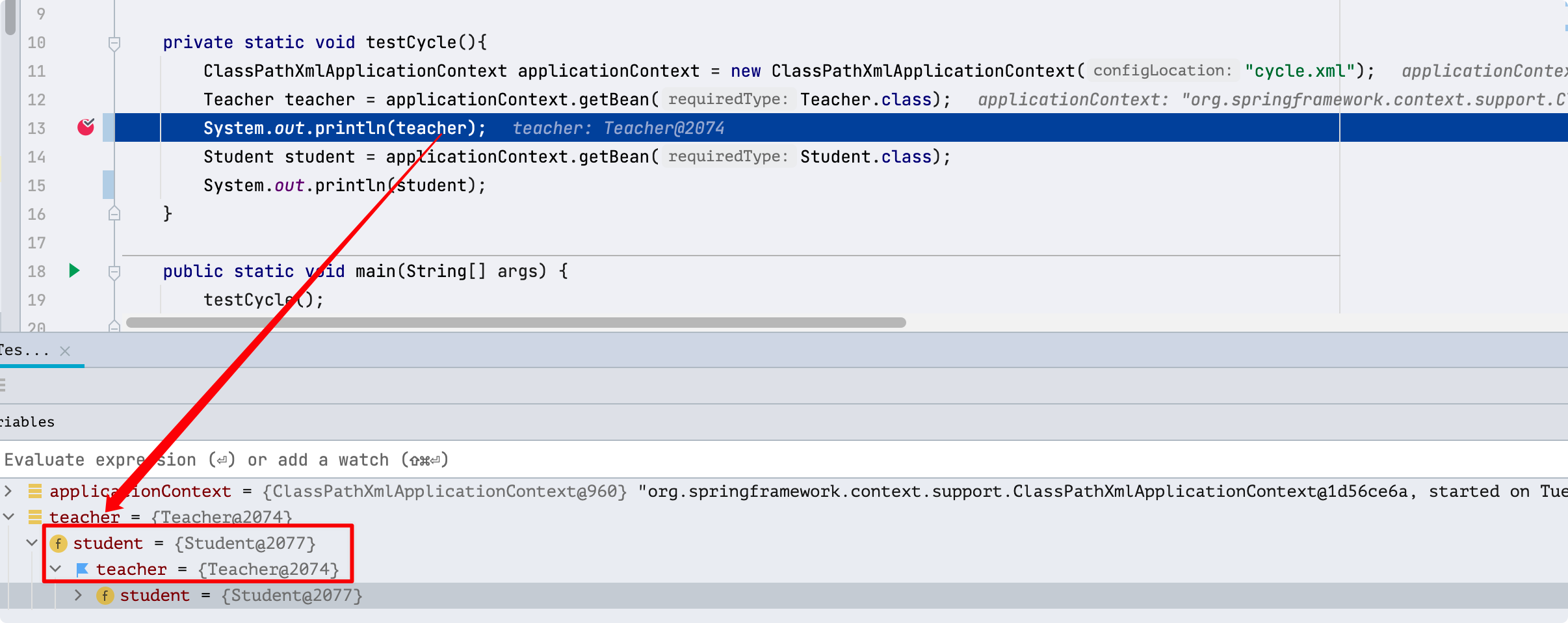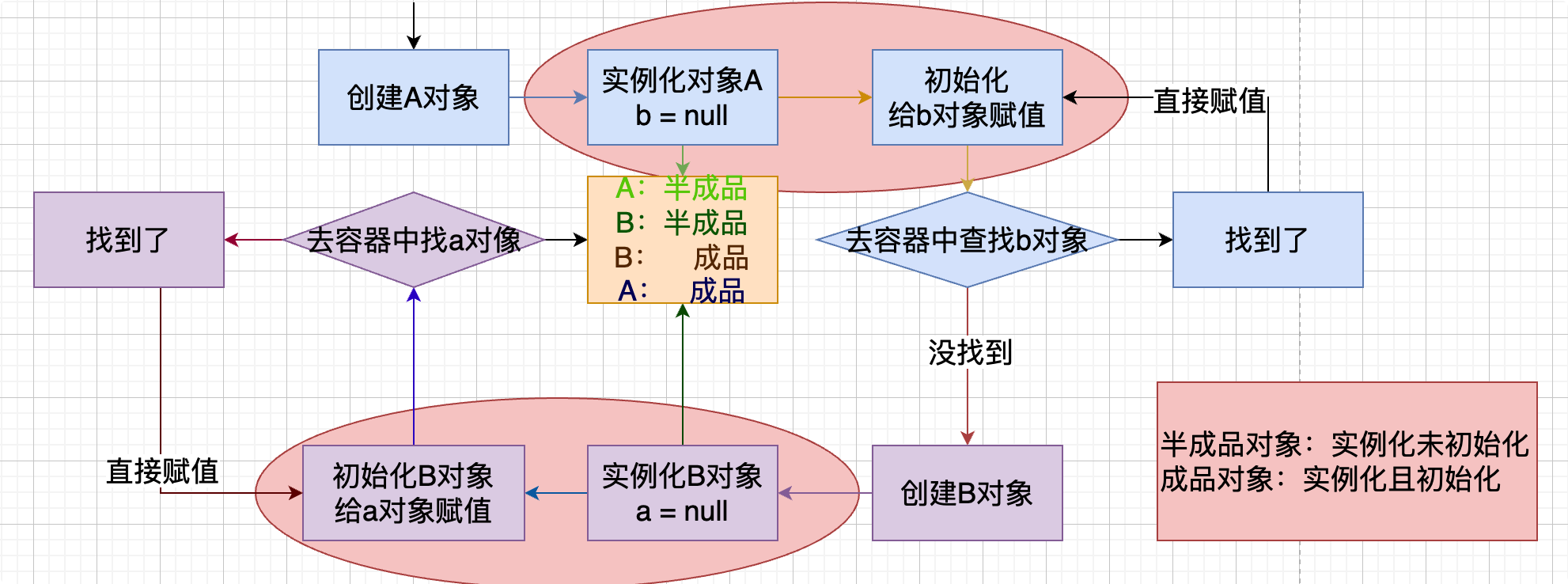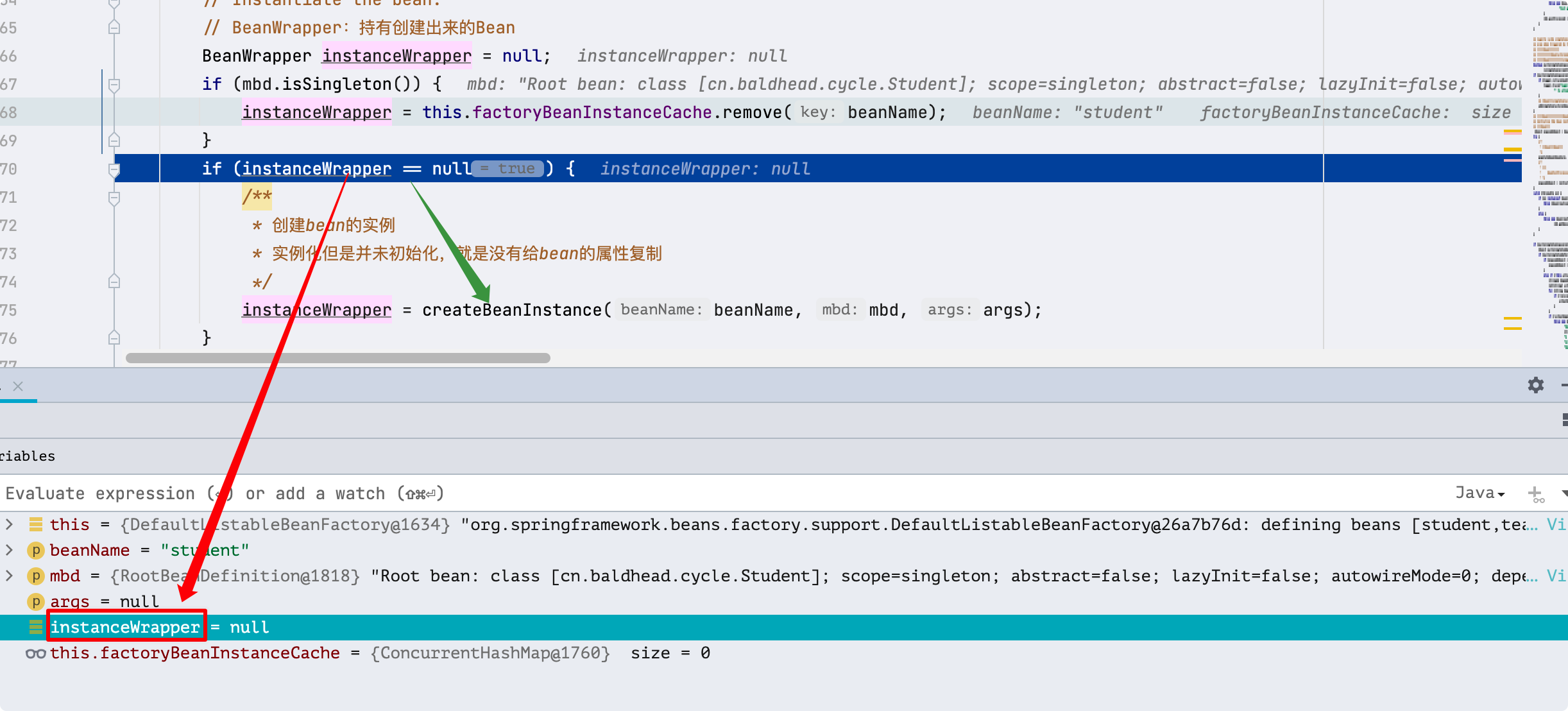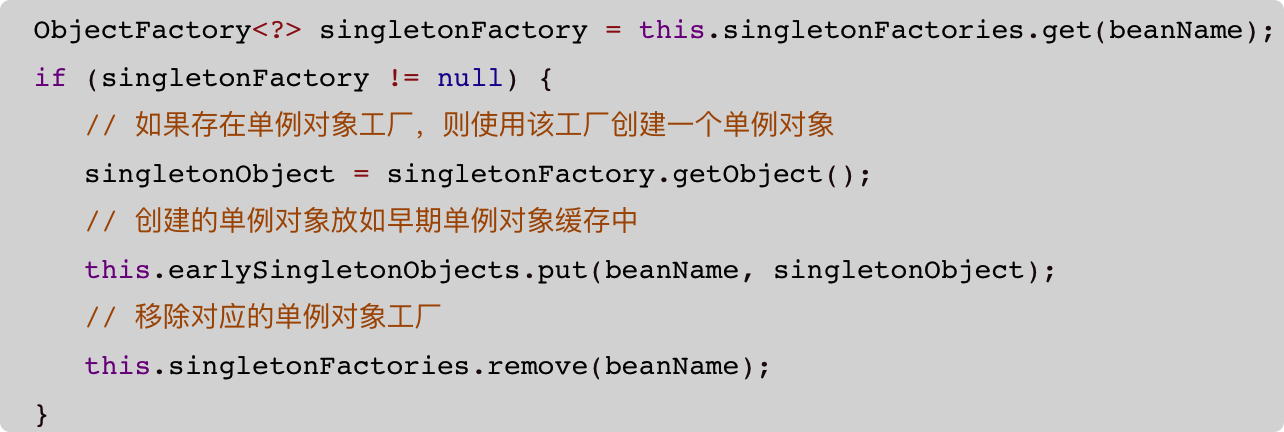Spring循环依赖原理
Spring循环依赖的原理解析
1、什么是循环依赖?
我们使用Spring的时候,在一个对象中注入另一个对象,但是另外的一个对象中也包含该对象。如图:

在Student中包含了teacher的一个属性;
在Teacher中包含有student的属性。这样就形成了一个循环依赖。
2、代码描述
xml配置文件

TestCycle.java
private static void testCycle(){
ClassPathXmlApplicationContext applicationContext = new ClassPathXmlApplicationContext("cycle.xml");
Teacher teacher = applicationContext.getBean(Teacher.class);
System.out.println(teacher);
Student student = applicationContext.getBean(Student.class);
System.out.println(student);
}
public static void main(String[] args) {
testCycle();
}
Student.java
public class Student {
private Teacher teacher;
public Teacher getTeacher() {
return teacher;
}
public void setTeacher(Teacher teacher) {
this.teacher = teacher;
}
}
Teacher.java
public class Teacher {
private Student student;
public Student getStudent() {
return student;
}
public void setStudent(Student student) {
this.student = student;
}
}
3、 测试结果

此处输出的teacher中包含有student对象,student对象中也包含有teacher对象,且包含的对象都是不为null的。
4、为什么能够循环依赖解释
< 56c p>先给出一张图

在Spring创建bean的时候肯定也是一个一个去创建的。首先肯定会先去走一个(Teacher/Student)生命周期。这里以Teacher为例,当Spring去getBean(teacher)的时候,首先会去容器中获取,获取不到就会去创建teacher,当teacher创建完成后,会给teacher的属性(student)赋值,实际上容器中没有student对象,这时候也会去创建student对象,当student创建的时候会去给student中的teacher属性赋值,teacher之前已经创建过了,此时去getBean(teacher)是能够拿到的(注意:此时的teacher中student属性并没有赋值),这样student就创建完成了,那么就会回到teacher的student属性赋值的步骤,此时student已经创建是可以用getBean()拿到的,这样teacher对象就创建完毕了。然后回到第一步去创建student对象,这里student对象在创建teacher的时候就已经创建,可以直接使用getBean()获取到。给student中的属性赋值的时候也是一样,能够直接获取到teacher。自此循环依赖就已经结束了。
5、疑问
- 当我在给Teacher属性student的赋值的时候是怎么去getBean()的?
- 当给student中 ad8 属性teacher赋值的时候getBean()为什么能够取到teacher?
- 为什么获取到的teacher属性是为完成注入的?
6、源码解释
整体的方法线

先看看源码:
getBean()->doGetBean()
getBean()->
doGetBean()实际上是
doGetBean在去获取bean对象
public <T> T getBean(String name, @Nullable Class<T> requiredType, @Nullable Object... args)
throws BeansException {
return doGetBean(name, requiredType, args, false);
}
/**
* Return an instance, which may be shared or independent, of the specified bean.
* 返回指定 bean 的一个实例,该实例可以是共享的,也可以是独立的。
*/
@SuppressWarnings("unchecked")
protected <T> T doGetBean(
String name, @Nullable Class<T> requiredType, @Nullable Object[] args, boolean typeCheckOnly)
throws BeansException {
// 转换beanName,FactoryBean的情况下beanName为&beanName,这里就是去掉&符号
String beanName = transformedBeanName(name);
Object beanInstance;
// Eagerly check singleton cache for manually registered singletons.
// 急切检查单例缓存从手动创建的单例中,获取bean判断是否存在当前beanName的bean
Object sharedInstance = getSingleton(beanName);
if (sharedInstance != null && args == null) {
if (logger.isTraceEnabled()) {
if (isSingletonCurrentlyInCreation(beanName)) {
... 省略代码...
}
beanInstance = getObjectForBeanInstance(sharedInstance, name, beanName, null);
}
else {
// Fail if we're already creating this bean instance:
// We're assumably within a circular reference.
// 没有获取到,如果已经创建bean的实例,我们在一个循环引用中。当前的bean是否为正在创建中
if (isPrototypeCurrentlyInCreation(beanName)) {
throw new BeanCurrentlyInCreationException(beanName);
}
// Check if bean definition exists in this factory.
// 检查该工厂中是否存在bean的定义
BeanFactory parentBeanFactory = getParentBeanFactory();
... 省略代码...
if (!typeCheckOnly) {
// 标记bean已经创建,正在创建
markBeanAsCreated(beanName);
}
StartupStep beanCreation = this.applicationStartup.start("spring.beans.instantiate")
.tag("beanName", name);
try {
if (requiredType != null) {
564
beanCreation.tag("beanType", requiredType::toString);
}
RootBeanDefinition mbd = getMergedLocalBeanDefinition(beanName);
checkMergedBeanDefinition(mbd, beanName, args);
// Guarantee initialization of beans that the current bean depends on.
// 保证当前的bean所依赖的bean已经初始化
String[] dependsOn = mbd.getDependsOn();
if (dependsOn != null) {
for (String dep : dependsOn) {
if (isDependent(beanName, dep)) {
throw new BeanCreationException(mbd.getResourceDescription(), beanName,
"Circular depends-on relationship between '" + beanName + "' and '" + dep + "'");
}
registerDependentBean(dep, beanName);
try {
getBean(dep);
}
catch (NoSuchBeanDefinitionException ex) {
throw new BeanCreationException(mbd.getResourceDescription(), beanName,
"'" + beanName + "' depends on missing bean '" + dep + "'", ex);
}
}
}
// Create bean instance.
// 创建bean的实例
if (mbd.isSingleton()) {
sharedInstance = getSingleton(beanName, () -> {
try {
return createBean(beanName, mbd,
ad8
args);
}
catch (BeansException ex) {
// Explicitly remove instance from singleton cache: It might have been put there
// eagerly by the creation process, to allow for circular reference resolution.
// Also remove any beans that received a temporary reference to the bean.
// 从单例缓存中删除实例,它可能已经在这里
// 通过创建过程-允许循环引用解析
// 删除接收到任何对bean引用的临时bean
destroySingleton(beanName);
throw ex;
}
});
beanInstance = getObjectForBeanInstance(sharedInstance, name, beanName, mbd);
}
else if (mbd.isPrototype()) {
// It's a prototype -> create a new instance.
Object prototypeInstance = null;
try {
beforePrototypeCreation(beanName);
prototypeInstance = createBean(beanName, mbd, args);
}
finally {
afterPrototypeCreation(beanName);
}
beanInstance = getObjectForBeanInstance(prototypeInstance, name, beanName, mbd);
}
... 省略代码...
finally {
beanCreation.end();
}
}
return adaptBeanInstance(name, beanInstance, requiredType);
}
此处传入进来的
beanName为teacher
doGetBean()->createBean()
分开看
// Create bean instance.
// 创建bean的实例
if (mbd.isSingleton()) {
sharedInstance = getSingleton(beanName, () -> {
try {
return createBean(beanName, mbd, args);
}
catch (BeansException ex) {
// Explicitly remove instance from singleton cache: It might have been put there
// eagerly by the creation process, to allow for circular reference resolution.
// Also remove any beans that received a temporary reference to the bean.
// 从单例缓存中删除实例,它可能已经在这里
// 通过创建过程-允许循环引用解析
// 删除接收到任何对bean引用的临时bean
destroySingleton(beanName);
throw ex;
}
});
beanInstance = getObjectForBeanInstance(sharedInstance, name, beanName, mbd);
}
重要的点在这里当没有获取到bean的时候就会去调用
createBean方法,创建bean,最终其实是走的
doCreateBean方法取创建bean
createBean()->doCreateBean()
这里就到了上面方法线的第四部< 2b60 /p>
protected Object doCreateBean(String beanName, RootBeanDefinition mbd, @Nullable Object[] args)
throws BeanCreationException {
// Instantiate the bean.
// BeanWrapper:持有创建出来的Bean
BeanWrapper instanceWrapper = null;
if (mbd.isSingleton()) {
instanceWrapper = this.factoryBeanInstanceCache.remove(beanName);
}
if (instanceWrapper == null) {
/**
* 创建bean的实例
* 实例化但是并未初始化,就是没有给bean的属性复制
*/
instanceWrapper = createBeanInstance(beanName, mbd, args);
}Object bean = instanceWrapper.getWrappedInstance();
Class<?> beanType = instanceWrapper.getWrappedClass();
if (beanType != NullBean.class) {
mbd.resolvedTargetType = beanType;
}
// Allow post-processors to modify the merged bean definition.
// 允许增强器修改合并的bean definition
synchronized (mbd.postProcessingLock) {
if (!mbd.postProcessed) {
try {
applyMergedBeanDefinitionPostProcessors(mbd, beanType, beanName);
}
catch (Throwable ex) {
throw new BeanCreationException(mbd.getResourceDescription(), beanName,
"Post-processing of merged bean definition failed", ex);
}
mbd.postProcessed = true;
}
}
// Eagerly cache singletons to be able to resolve circular references
// even when triggered by lifecycle interfaces like BeanFactoryAware.
// 缓存单例的bean能够解析循环引用
// 即使生命周期接口触发像BeanFactoryAware,
// 判断当前的bean是否需要提前曝光(加入singletonFactories缓存):bean是单例的&允许循环依赖&bean正在创建
boolean earlySingletonExposure = (mbd.isSingleton() && this.allowCircularReferences &&
isSingletonCurrentlyInCreation(beanName));
if (earlySingletonExposure) {
if (logger.isTraceEnabled()) {
logger.trace("Eagerly caching bean '" + beanName +
"' to allow for resolving potential circular references");
}
// 将bean添加到singletonFactories 也就是说的三级缓存,但是这个地方的属性是没有赋值的
addSingletonFactory(beanName, () -> getEarlyBeanReference(beanName, mbd, bean));
}// 到这里,bean就已经实例化完成,并且将bean放入到了singletonFactories缓存中
// Initialize the bean instance.
// 初始化bean的实例
Object exposedObject = bean;
try {
/**
* 填充bean,填充Bean的属性
*/
populateBean(beanName, mbd, instanceWrapper);
/**
* 去执行
* BeanPostProcessor的postProcessBeforeInitialization方法
* */
exposedObject = initializeBean(beanName, exposedObject, mbd);
}
catch (Throwable ex) {
if (ex instanceof BeanCreationException && beanName.equals(((BeanCreationException) ex).getBeanName())) {
throw (BeanCreationException) ex;
}
else {
throw new BeanCreationException(
mbd.getResourceDescription(), beanName, "Initialization of bean failed", ex);
}
}
if (earlySingletonExposure) {
Object earlySingletonReference = getSingleton(beanName, false);
if (earlySingletonReference != null) {
if (exposedObject == bean) {
exposedObject = earlySingletonReference;
}
else if (!this.allowRawInjectionDespiteWrapping && hasDependentBean(beanName)) {
String[] dependentBeans = getDependentBeans(beanName);
Set<String> actualDependentBeans = new LinkedHashSet<>(dependentBeans.length);
for (String dependentBean : dependentBeans) {
if (!removeSingletonIfCreatedForTypeCheckOnly(dependentBean)) {
actualDependentBeans.add(dependentBean);
}
}
if (!actualDependentBeans.isEmpty()) {
throw new BeanCurrentlyInCreationException(beanName,
"Bean with name '" + beanName + "' has been injected into other beans [" +
StringUtils.collectionToCommaDelimitedString(actualDependentBeans) +
"] in its raw version as part of a circular reference, but has eventually been " +
"wrapped. This means that said other beans do not use the final version of the " +
"bean. This is often the result of over-eager type matching - consider using " +
"'getBeanNamesForType' with the 'allowEagerInit' flag turned off, for example.");
}
}
}
}
// Register bean as disposable.
// 将bean注册为一次性的
try {
registerDisposableBeanIfNecessary(beanName, bean, mbd);
}
catch (BeanDefinitionValidationException ex) {
throw new BeanCreationException(
mbd.getResourceDescription(), beanName, "Invalid destruction signature", ex);
}
return exposedObject;
}
分开解释doCreateBean方法
// Instantiate the bean.
// BeanWrapper:持有创建出来的Bean
BeanWrapper instanceWrapper = null;
if (mbd.isSingleton()) {
instanceWrapper = this.factoryBeanInstanceCache.remove(beanName);
}
if (instanceWrapper == null) {
/**
* 创建bean的实例
* 实例化但是并未初始化,就是没有给bean的属性复制
*/
instanceWrapper = createBeanInstance(beanName, mbd, args);
}
初始化
bean,这个地方开始调用
createBeanInstance方法创建一个bean的实例

// Eagerly cache singletons to be able to resolve circular references
// even when triggered by lifecycle interfaces like BeanFactoryAware.
// 缓存单例的bean能够解析循环引用
// 即使生命周期接口触发像BeanFactoryAware,
// 判断当前的bean是否需要提前曝光(加入singletonFactories缓存):bean是单例的&允许循环依赖&bean正在创建
boolean earlySingletonExposure = (mbd.isSingleton() && this.allowCircularReferences &&
isSingletonCurrentlyInCreation(beanName));
if (earlySingletonExposure) {
if (logger.isTraceEnabled()) {
logger.trace("Eagerly caching bean '" + beanName +
"' to allow for resolving potential circular references");
}
// 将bean添加到singletonFactories 也就是说的三级缓存,但是这个地方的属性是没有赋值的
addSingletonFactory(beanName, () -> getEarlyBeanReference(beanName, mbd, bean));
}
记住
addSingletonFactory()方法,这是循环依赖的核心
protected void addSingletonFactory(String beanName, ObjectFactory<?> singletonFactory) {
Assert.notNull(singletonFactory, "Singleton factory must not be null");
synchronized (this.singletonObjects) {
if (!this.singletonObjects.containsKey(beanName)) {
// 将beanName,singletonFactory放入到单例工厂的缓存【beanName-singletonFactory】
this.singletonFactories.put(beanName, singletonFactory);
// 从早起的单例对象缓存中移除【beanName-bean实例】
this.earlySingletonObjects.remove(beanName);
// 将beanName添加到已经注册的实例中
this.registeredSingletons.add(beanName);
}
}
}
此处存入的
singletonFactory是一个lambda表达式,
ObjectFactory是一个函数接口,当执行
getObject方法的时候会去调用存入的
getEarlyBeanReference(beanName, mbd, bean)
doCreateBean() -> createBeanInstance()
这里也没什么好说的就是通过反射去创建Teacher对象
createBeanInstance() -> populateBean()
这里就是开始给创建的Teacher属性student赋值了
/**
* Populate the bean instance in the given BeanWrapper with the property values
* from the bean definition.
* @param beanName the name of the bean
* @param mbd the bean definition for the bean
* @param bw the BeanWrapper with bean instance
* 允许属性值填充给BeanWrapper中的Bean实例
*/
@SuppressWarnings("deprecation") // for postProcessPropertyValues 后处理属性值
protected void populateBean(String beanName, RootBeanDefinition mbd, @Nullable BeanWrapper bw) {
... 省略代码 ...
// Give any InstantiationAwareBeanPostProcessors the opportunity to modify the 给所有InstantiationAwareBeanPostProcessors有修改的机会
// state of the bean before properties are set. This can be used, for example,
// to support styles of field injection.
// 设置属性之前bean的状态,例如
// 支持字段注入
if (!mbd.isSynthetic() && hasInstantiationAwareBeanPostProcessors()) {
for (InstantiationAwareBeanPostProcessor bp : getBeanPostProcessorCache().instantiationAware) {
if (!bp.postProcessAfterInstantiation(bw.getWrappedInstance(), beanName)) {
return;
}
}
}PropertyValues pvs = (mbd.hasPropertyValues() ? mbd.getPropertyValues() : null);
int resolvedAutowireMode = mbd.getResolvedAutowireMode();
if (resolvedAutowireMode == AUTOWIRE_BY_NAME || resolvedAutowireMode == AUTOWIRE_BY_TYPE) {
MutablePropertyValues newPvs = new MutablePropertyValues(pvs);
// Add property values based on autowire by name if applicable. 通过名称自动注入参数的值
if (resolvedAutowireMode == AUTOWIRE_BY_NAME) {
autowireByName(beanName, mbd, bw, newPvs);
}
// Add property values based on autowire by type if applicable. 通过类型注入参数的值
if (resolvedAutowireMode == AUTOWIRE_BY_TYPE) {
autowireByType(beanName, mbd, bw, newPvs);
}
pvs = newPvs;
}
/**
* 有没有实例化的AwareBeanPostProcessor
*/
boolean hasInstAwareBpps = hasInstantiationAwareBeanPostProcessors();
/**
* 是否需要深度检查
*/
boolean needsDepCheck = (mbd.getDependencyCheck() != AbstractBeanDefinition.DEPENDENCY_CHECK_NONE);
if (hasInstAwareBpps) {
if (pvs == null) {
pvs = mbd.getPropertyValues();
}
for (InstantiationAwareBeanPostProcessor bp : getBeanPostProcessorCache().instantiationAware) {
PropertyValues pvsToUse = bp.postProcessProperties(pvs, bw.getWrappedInstance(), beanName);
if (pvsToUse == null) {
return;
}
pvs = pvsToUse;
}
}
if (needsDepCheck) {
PropertyDescriptor[] filteredPds = filterPropertyDescriptorsForDependencyCheck(bw, mbd.allowCaching);
checkDependencies(beanName, mbd, filteredPds, pvs);
}
if (pvs != null) {
ad8
// 应用给定的属性值,解决任何在这个bean工厂运行时它bean的引用。必须使用深copy。所以不会永久的修改此属性
applyPropertyValues(beanName, mbd, bw, pvs);
}
}
分开解析
if (!mbd.isSynthetic() && hasInstantiationAwareBeanPostProcessors()) {
for (InstantiationAwareBeanPostProcessor bp : getBeanPostProcessorCache().instantiationAware) {
if (!bp.postProcessAfterInstantiation(bw.getWrappedInstance(), beanName)) {
return;
}
}
}
InstantiationAwareBeanPostProcessor的方法
postProcessAfterInstantiation,该方法的返回值是boolean,如果返回true,则什么都不干,如果返回false,那么此类则不会进行自动装配(属性填充),这里就是可以让我们通过
postprocessor的方式控制某些bean不用属性填充。这里很明显如果我们没做特殊处理,这里最里面的if的return是不会被执行到的。
if (pvs != null) {
// 应用给定的属性值,解决任何在这个bean工厂运行时它bean的引用。必须使用深copy。所以不会永久的修改此属性
applyPropertyValues(beanName, mbd, bw, pvs);
}
这里就是给Teacher的student属性赋值的
/**
* Apply the given property values, resolving any runtime references
* to other beans in this bean factory. Must use deep copy, so we
* don't permanently modify this property.
* @param beanName the bean name passed for better exception information
* @param mbd the merged bean definition
* @param bw the BeanWrapper wrapping the target object
* @param pvs the new property values
* 应用给定的属性值,解析对此 bean 工厂中其他 bean 的任何运行时引用。必须使用深拷贝,所以我们不会永久修改这个属性
*/
protected void applyPropertyValues(String beanName, BeanDefinition mbd, BeanWrapper bw, PropertyValues pvs) {
if (pvs.isEmpty()) {
// 如果pvs没有propertyValues,直接结束
return;
}
MutablePropertyValues mpvs = null;
List<PropertyValue> original;
if (pvs instanceof MutablePropertyValues) {
mpvs = (MutablePropertyValues) pvs;
if (mpvs.isConverted()) {
// Shortcut: use the pre-converted values as-is.
try {
bw.setPropertyValues(mpvs);
return;
}
catch (BeansException ex) {
throw new BeanCreationException(
mbd.getResourceDescription(), beanName, "Error setting property values", ex);
}
}
original = mpvs.getPropertyValueList();
}
else {
original
56b
= Arrays.asList(pvs.getPropertyValues());
}
TypeConverter converter = getCustomTypeConverter();
if (converter == null) {
converter = bw;
}
BeanDefinitionValueResolver valueResolver = new BeanDefinitionValueResolver(this, beanName, mbd, converter);
// Create a deep copy, resolving any references for values. 创建一个深copy,解析任何引用值
List<PropertyValue> deepCopy = new ArrayList<>(original.size());
boolean resolveNecessary = false;
for (PropertyValue pv : original) {
if (pv.isConverted()) {
deepCopy.add(pv);
}
else {
// 获取属性的名称
String propertyName = pv.getName();
// 获取属性的值
Object originalValue = pv.getValue();
if (originalValue == AutowiredPropertyMarker.INSTANCE) {
Method writeMethod = bw.getPropertyDescriptor(propertyName).getWriteMethod();
if (writeMethod == null) {
throw new IllegalArgumentException("Autowire marker for property without write method: " + pv);
}
originalValue = new DependencyDescriptor(new MethodParameter(writeMethod, 0), true);
}
// 解析属性值
Object resolvedValue = valueResolver.resolveValueIfNecessary(pv, originalValue);
Object convertedValue = resolvedValue;
boolean convert
ad1
ible = bw.isWritableProperty(propertyName) &&
!PropertyAccessorUtils.isNestedOrIndexedProperty(propertyName);
if (convertible) {
convertedValue = convertForProperty(resolvedValue, propertyName, bw, converter);
}
// Possibly store converted value in merged bean definition,
// in order to avoid re-conversion for every created bean instance.
if (resolvedValue == originalValue) {
if (convertible) {
pv.setConvertedValue(convertedValue);
}
deepCopy.add(pv);
}
else if (convertible && originalValue instanceof TypedStringValue &&
!((TypedStringValue) originalValue).isDynamic() &&
!(convertedValue instanceof Collection || ObjectUtils.isArray(convertedValue))) {
pv.setConvertedValue(convertedValue);
deepCopy.add(pv);
}
else {
resolveNecessary = true;
deepCopy.add(new PropertyValue(pv, convertedValue));}
}
}
if (mpvs != null && !resolveNecessary) {
mpvs.setConverted();
}
// Set our (possibly massaged) deep copy.
try {
bw.setPropertyValues(new MutablePropertyValues(deepCopy));
}
catch (BeansException ex) {
throw new BeanCreationException(
mbd.getResourceDescription(), beanName, "Error setting property values", ex);
}
}
解析属性值
Object resolvedValue = valueResolver.resolveValueIfNecessary(pv, originalValue);

此处会直接走到
resolveReference方法中去
/**
* Resolve a reference to another bean in the factory.解析对另一个bean的引用
*/
@Nullable
private Object resolveReference(Object argName, RuntimeBeanReference ref) {
try {
// 用来存放实例化出来的bean
Object bean;
// 获取bean的类型
Class<?> beanType = ref.getBeanType();
if (ref.isToParent()) {
BeanFactory parent = this.beanFactory.getParentBeanFactory();
if (parent == null) {
... 省略代码 ...
}
else {
String resolvedName;
if (beanType != null) {
... 省略代码...
}
else {
resolvedName = String.valueOf(doEvaluate(ref.getBeanName()));
// 获取resolvedName的bean对象
bean = this.beanFactory.getBean(resolvedName);
}// 注册依赖的beanthis.beanFactory.registerDependentBean(resolvedNam
1044
e, this.beanName);
}
if (bean instanceof NullBean) {
bean = null;
}
return bean;
}
catch (BeansException ex) {
throw new BeanCreationException(
this.beanDefinition.getResourceDescription(), this.beanName,
"Cannot resolve reference to bean '" + ref.getBeanName() + "' while setting " + argName, ex);
}
}
方法会走到这里去getBean() 之前的getBean还没走完是不是有走到getBean(),从这里开始就是套娃。
resolvedName = String.valueOf(doEvaluate(ref.getBeanName())); // 获取resolvedName的bean对象 bean = this.beanFactory.getBean(resolvedName); }// 注册依赖的bean
到此处就会去寻找Student的实例,就会走一遍之前的方法,但是走到
pupolate()方法的时候给student的teacher属性赋值,会去容器中获取一个teacher,还记得之前存在singletonFactories中的teacher吗?这里获取的时候就会直接拿到之前的存储的teacher。下面看一看
省略之前创建个逻辑,直接到赋值的操作

到这里就开始去获取teacher对象了,看一下
getSingleton()方法是怎么拿的;
protected Object getSingleton(String beanName, boolean allowEarlyReference) {
// Quick check for existing instance without full singleton lock
// 从单例对象缓存(singletonObjects--一级缓存)中获取bean对象
Object singletonObject = this.singletonObjects.get(beanName);
// 如果单例对象中没有找到,并且改bean正在创建中
if (singletonObject == null && isSingletonCurrentlyInCreation(beanName)) {
// 从早期单例对象缓存中获取单例对象(之所以成为早期单例对象,是因为earlySingletonObjects里面
// 的对象都是通过提前曝光的ObjectFactory创建出来的。还没有进行属性填充等操作)
singletonObject = this.earlySingletonObjects.get(beanName);
// 早期单例对象缓存(二级缓存)中也没有并且允许创建早期单例对象
if (singletonObject == null && allowEarlyReference) {
// 如果为空,则锁定全局变量进行处理
synchronized (this.singletonObjects) {
// Consistent creation of early reference within full singleton lock
//在完整的单例锁中一致地创建早期引用
singletonObject = this.singletonObjects.get(beanName);
if (singletonObject == null) {
singletonObject = this.earlySingletonObjects.get(beanName);
if (singletonObject == null) {
// 当某些方法需要提前初始化的时候则会调用addSingletonFactory方法将对应的objectFactory初始化策略储存在singletonFactories中
ObjectFactory<?> singletonFactory = this.singletonFactories.get(beanName);
if (singletonFactory != null) {
// 如果存在单例对象工厂,则使用该工厂创建一个单例对象
singletonObject = singletonFactory.getObject();
// 创建的单例对象放如早期单例对象缓存中
this.earlySingletonObjects.put(beanName, singletonObject);
// 移除对应的单例对象工厂
this.singletonFactories.remove(beanName);
}
}
}
}
}
}
return singletonObject;
}

这里拿到了之前存入
singletonFactoriesMap中的lambda表达式,调用
getObject()方法去执行
getEarlyBeanReference方法
/**
* Obtain a
ad8
reference for early access to the specified bean,
* typically for the purpose of resolving a circular reference.
* @param beanName the name of the bean (for error handling purposes)
* @param mbd the merged bean definition for the bean
* @param bean the raw bean instance
* @return the object to expose as bean reference
*
* 获得对指定bean的早期访问的引用 通常用于解析循环依赖
*/
protected Object getEarlyBeanReference(String beanName, RootBeanDefinition mbd, Object bean) {
// 默认最终公开的对象是bean,通过createBeanInstance创建出来的普通对象
Object exposedObject = bean;
// mbd的synthetic属性:设置bean定义是否是synthetic的,一般是指只有AOP相关的pointCut配置或者advice配置才会将synthetic设置为true
// 如果mbd不是synthetic且此工厂拥有InstantiationAwareBeanPostProcessor
if (!mbd.isSynthetic() && hasInstantiationAwareBeanPostProcessors()) {
// 遍历工厂的所有后置处理器,并获取smartInstantiationAware-ArrayList
for (SmartInstantiationAwareBeanPostProcessor bp : getBeanPostProcessorCache().smartInstantiationAware) {
// 让exposedObject对象经过每一个smartInstantiationAwareBeanPostProcessor报装
exposedObject = bp.getEarlyBeanReference(exposedObject, beanName);
}
}
// 返回最终经过层次报装后的对象
return exposedObject;
}
这个方法没有什么好解释的,注释很明确的表明了方法的作用
拿到teacher之后就给Student中的teacher属性赋值
resolveNecessary = true; deepCopy.add(new PropertyValue(pv, convertedValue));
就此Student对像创建完毕,会将创建完成的Student对象放入
try {
// 去容器中获取bean对象
singletonObject = singletonFactory.getObject();
newSingleton = true;
}
catch (IllegalStateException ex) {
// Has the singleton object implicitly appeared in the meantime ->
// if yes, proceed with it since the exception indicates that state.
singletonObject = this.singletonObjects.get(beanName);
if (singletonObject == null) {
throw ex;
}
}
catch (BeanCreationException ex) {
if (recordSuppressedExceptions) {
for (Exception suppressedException : this.suppressedExceptions) {
ex.addRelatedCause(suppressedException);
}
}
throw ex;
}
finally {
if (recordSuppressedExceptions) {
this.suppressedExceptions = null;
}
afterSingletonCreation(beanName);
}
if (newSingleton) {
// 将beanName和singletonObject的映射关系添加到该工厂的单例缓存中
addSingleton(beanName, singletonObject);
}
addSingleton(beanName, singletonObject);放入缓存中
至此会返回去给Teacher中的student属性赋值。至此一次的循环依赖就完成了。Spring还回去创建Student对象,但是这次容器中存在直接取出来就可以了。
疑问解答
为什么最后还要去创建一次Student对象,因为开始创建Student对象是因为创建Teacher对象的时候需要使用Student得实例,所以去创建了一次,但是最后一次去创建Student对象的时候不会真的创建,直接从缓存singletonObjects中就能去获取到。
如文章中有错误欢迎指出,刚开始阅读代码,参考了一些资料。
- Spring源码解析之Bean创建的核心步骤,三级缓存解决循环依赖的原理分析
- spring: 我是如何解决循环依赖的?
- Spring-bean的循环依赖以及解决方式
- Spring @Async 应用于出现循环依赖的 Bean 报错的解决方案
- 详解Spring依赖注入:@Autowired,@Resource和@Inject区别与实现原理
- 【第三章】 DI 之 3.2 循环依赖 ——跟我学spring3
- 帮助你更好的理解Spring循环依赖
- 【Spring学习笔记】之【3.2 避免循环依赖】
- spring循环依赖问题分析
- Spring循环依赖
- Spring源码解读--(二、Spring如何判断构造器注入时的循环依赖)
- Spring源码解析:循环依赖的探测与处理
- spring循环依赖源码解决分析
- [跟我学spring学习笔记][DI循环依赖]
- spring 控制反转和依赖注入 原理解析
- 【第三章】 DI 之 3.2 循环依赖 ——跟我学spring3
- spring依赖注入的实现原理
- Spring中的循环依赖问题介绍及解决方法
- spring循环依赖的解决
- Spring学习笔记——Spring依赖注入原理分析
